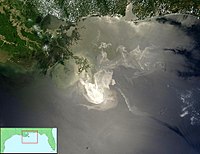
Photo from wikipedia
With the wide application of petroleum resources, oil substances have polluted the environment in every link from crude oil extraction to utilization. Cement-based materials are the main materials in civil… Click to show full abstract
With the wide application of petroleum resources, oil substances have polluted the environment in every link from crude oil extraction to utilization. Cement-based materials are the main materials in civil engineering, and the study of their adsorption capacity for oil pollutants can expand the scope of functional engineering applications of cement-based materials. Based on the research status of the oil-wet mechanism of different kinds of oil-absorbing materials, this paper lists the types of conventional oil-absorbing materials and introduces their application in cement-based materials while outlining the influence of different oil-absorbing materials on the oil-absorbing properties of cement-based composites. The analysis found that 10% Acronal S400F emulsion can reduce the water absorption rate of cement stone by 75% and enhance the oil-absorption rate by 62%. Adding 5% polyethylene glycol can increase the oil–water relative permeability of cement stone to 1.2. The oil-adsorption process is described by kinetic and thermodynamic equations. Two isotherm adsorption models and three adsorption kinetic models are explained, and oil-absorbing materials and adsorption models are matched. The effects of specific surface area, porosity, pore interface, material outer surface, oil-absorption strain, and pore network on the oil-absorption performance of materials are reviewed. It was found that the porosity has the greatest influence on the oil-absorbing performance. When the porosity of the oil-absorbing material increases from 72% to 91%, the oil absorption can increase to 236%. In this paper, by analyzing the research progress of factors affecting oil-absorption performance, ideas for multi-angle design of functional cement-based oil-absorbing materials can be obtained.
Journal Title: Materials
Year Published: 2023
Link to full text (if available)
Share on Social Media: Sign Up to like & get
recommendations!